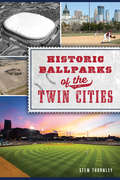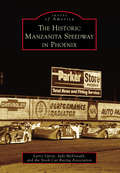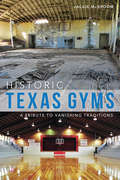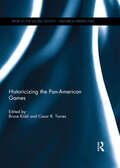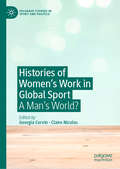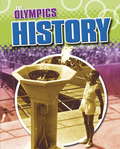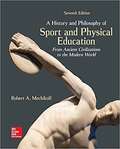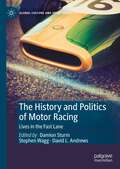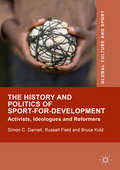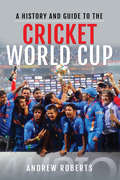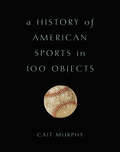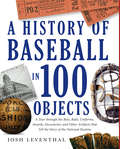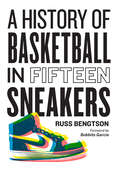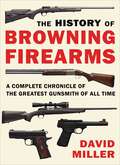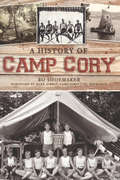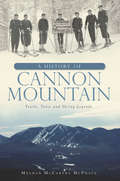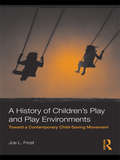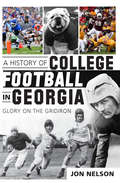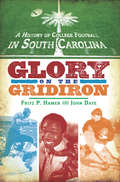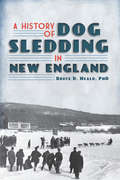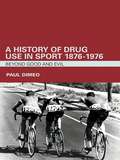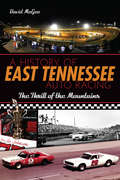- Table View
- List View
Historic Ballparks of the Twin Cities (Sports)
by Stew ThornleyFrom the rickety to the palatial, ballparks have grown up with and defined baseball in Minneapolis and St. Paul. Some old-timers have vivid memories of cheering for Willie Mays and Roy Campanella at Nicollet and Lexington. Others marveled at a majestic Killebrew home run at the Met. Many a lucky resident celebrated two world championships in the Metrodome and witnessed one of the greatest pitching performances in World Series history. More recently, fans have enjoyed the return of sunshine and even raindrops at Target Field. Described by City Pages as "the most respected local baseball historian," Stew Thornley leads a tour of where we--as well as our grandparents and now our children--discovered baseball.
The Historic Manzanita Speedway in Phoenix (Images of America)
by Larry Upton Stock Car Racing Association Judy McdonaldPhoenix's Manzanita Speedway, the last of the big dirt tracks located near the central corridor of a major metropolitan area, is now gone. The track opened in the early 1950s when Jack Holloway, president of the Arizona Jalopy Racing Association, along with Avery Doyle and Gene Gunn, set about convincing Rudy Everett and Larry Meskimen to convert their unprofitable dog-racing operation into a quarter-mile dirt track. On August 25, 1951, Everett and Meskimen beamed with excitement as Manzy opened to an overflowing crowd. They had tapped into America's post-World War II craze for automobiles and found their own Lost Dutchman Gold Mine in the process. Manzanita Speedway dominated dirt-track racing in Phoenix and was heralded as one of the top five dirt tracks in the United States. Manzy became an integral part of the racing culture in Phoenix, and its sale and closure in 2009 created a sense of lingering disappointment.
Historic Texas Gyms: A Tribute to Vanishing Traditions (Landmarks)
by Jackie McBroomFor generations of small-town Texans, the school gymnasium was the hub of the community. If it was a Tuesday night in Texline, most folks could be found in the old tin barn of a gym, rooting for their Tornadoes against the arch-rival Adrian Matadors. Transcending the role of a sports arena, the gym also provided a place to gather in celebration or shelter in crisis. Sadly, with the dramatic reduction of school districts around the state, many of the polished floorboards that once hosted graduations and beauty pageants now splinter beneath the weight of storage, farm equipment and guano-covered junk. From the pickup basketball game Elvis played in Hawkins to the tragic account of four Ennis war heroes, Jackie McBroom recounts stories from these beloved halls.
The Historical Sociology of Japanese Martial Arts (Routledge Research in Sport, Culture and Society)
by Raul Sanchez GarciaWinner of the Norbert Elias Book Prize 2020 This is the first long-term analysis of the development of Japanese martial arts, connecting ancient martial traditions with the martial arts practised today. The Historical Sociology of Japanese Martial Arts captures the complexity of the emergence and development of martial traditions within the broader Japanese Civilising Process. The book traces the structured process in which warriors’ practices became systematised and expanded to the Japanese population and the world. Using the theoretical framework of Norbert Elias’s process-sociology and drawing on rich empirical data, the book also compares the development of combat practices in Japan, England, France and Germany, making a new contribution to our understanding of the socio-cultural dynamics of state formation. Throughout this analysis light is shed onto a gender blind spot, taking into account the neglected role of women in martial arts. The Historical Sociology of Japanese Martial Arts is important reading for students of Socio-Cultural Perspectives in Sport, Sociology of Physical Activity, Historical Development of Sport in Society, Asian Studies, Sociology and Philosophy of Sport, and Sports History and Culture. It is also a fascinating resource for scholars, researchers and practitioners interested in the historical and socio-cultural aspects of combat sport and martial arts.
Historicizing the Pan-American Games (Sport in the Global Society - Historical Perspectives)
by Bruce Kidd and Cesar R. TorresThe Pan-American Games, begun officially in 1951 in Buenos Aires and held in every region of the western hemisphere, have become one of the largest multi-sport games in the world. 6,132 athletes from 41 countries competed in 48 sports in the 2015 Games in Toronto, Canada. The Games are simultaneously an avenue for the spread of the Olympic Movement across the Americas, a stage for competing ideologies of Pan-American unity, and an occasion for host city infrastructural stimulus and economic development. And yet until this volume, the Games have never been studied as a single entity from a scholarly viewpoint. Historicizing the Pan-American Games presents 12 original articles on the Games. Topics range from the origins of the Games in the period between the world wars, to their urban, hemispheric and cultural legacies, to the policy implications of specific Games for international sport. The entire collection is set against the shifting economic, social, political, cultural, sporting and artistic contexts of the turbulent western hemisphere. Historicizing the Pan-American Games makes a significant contribution to the literature on major games, Olympic sport and sport in the western hemisphere. This book was previously published as a special issue of The International Journal of the History of Sport.
Histories of Women's Work in Global Sport: A Man’s World? (Palgrave Studies in Sport and Politics)
by Georgia Cervin Claire NicolasSport has never been a man’s world. As this volume shows, women have served key roles not only as athletes and spectators, but as administrators, workers, decision-makers, and leaders in sporting organizations around the world. Contributors excavate scarce archival material to uncover histories of women’s work in sport, from swimming teachers in nineteenth-century England to national sports administrators in twentieth-century Côte d’Ivoire, and many places in between. Their work has been varied, holding roles as teachers, wives, and secretaries in sporting contexts around the world, often with diplomatic functions—including at the 1968 and 1992 Olympic Games. Finally, this collection shows how gender initiatives have developed in sporting institutions in Europe and international sport federations today. With a foreword by Grégory Quin and afterword by Anaïs Bohuon, this is a pioneering study into gender and women’s work in global sport.
History
by Moira ButterfieldEach title of The Olympics examines the the Olympic Games from ancient times, then the revival of the 1890s through to today's multi-million pound business. From the history of the games to which events are included and why, and from scandals to record breakers, The Olympics puts the reader at the centre of the action with fact-packed text, dramatic full-colour photos, facts and statistics.
History (The Olympics #3)
by Moira ButterfieldEach title of The Olympics examines the the Olympic Games from ancient times, then the revival of the 1890s through to today's multi-million pound business. From the history of the games to which events are included and why, and from scandals to record breakers, The Olympics puts the reader at the centre of the action with fact-packed text, dramatic full-colour photos, facts and statistics.
A History and Philosophy of Sport and Physical Education: From Ancient Civilizations to the Modern World
by Robert MechikoffA History and Philosophy of Sport and Physical Education - From Ancient Civilizations to the Modern World, has been meaningfully written to engage readers with essential information and critical introspection that is meant to inspire and educate. This edition highlights salient individuals, movements, beliefs, and events that have impacted the long and storied historical and philosophical development of sport, physical education, and kinesiology. Robert Mechikoff offers students a layered and scholarly look into the sports and physical activities of the world - ranging from Ancient Egypt, Greece, and Rome to the emergence of the professional and academic disciplines of physical education and kinesiology in the modern world, as well as the political and social modern realities of the Olympic Games.
The History and Politics of Motor Racing: Lives in the Fast Lane (Global Culture and Sport Series)
by Damion Sturm Stephen Wagg David L. AndrewsThis book explores the history and politics of motor racing, one of the most popular and lucrative elements in the international sport industry. Written by a group of international scholars and motor racing specialists it discusses the sport’s origins, the relationship of motor racing to nation building and modernity (noting its links to fascism and dictatorship), the links between motor racing and the automobile industry, motor racing and the politics both of gender and of race, motor racing, the media and postmodernity, and motor racing, the spatial and globalization. This book speaks to scholars in history, politics, sport studies, the sociology of sport, sport management and cultural studies, along with the many lay readers who are interested in the relationship between motor sport and society.
The History and Politics of Sport-for-Development: Activists, Ideologues and Reformers (Global Culture and Sport Series)
by Bruce Kidd Russell Field Simon C. DarnellThis book focuses on the major social and political forces that have shaped the ways in which sport has been understood, organized, and contested in an effort to engender social change. Integrating the history of international development with the history of modern sport, the authors examine the underpinnings of sport-for-development from the mid-19th through the early 21st centuries. Including both archival research and extensive interviews with more than 15 individuals who were central to the institutions and movements that shaped sport as a force for development, this book will be of particular interest to the growing number of scholars, students, practitioners, advocates and activists interested in the possibilities and limitations of sport-for-development.
A History & Guide to the Cricket World Cup
by Andrew RobertsA corker cricket book for longtime fans and rookies alike—a history of each of the eleven World Cup tournaments, including in-depth statistics. The Cricket World Cup is one of the most watched global sporting events and its celebrated history consumes fans around the world. Now, each of the eleven tournaments has been written up to include records of matches and individual performances, as well as a brief setting of the scene. Clear and concise, these chapters include the relevant statistics (highest and lowest totals, match aggregates, highest partnerships, top individual batting and bowling performances and biggest and smallest victory margins, etc.). Quirky findings such as the lowest team total to include a century partnership, birthday performances, most batsmen bowled out in an innings, as well as many more, are revealed in the miscellany section, and are sure to delight cricket lovers. A History & Guide to the Cricket World Cup is informative, factual and engaging, making it the perfect companion for fans.
A History of American Sports in 100 Objects
by Cait MurphyBeautifully designed and carefully curated, a fascinating collection of the things that shaped the way we live and play in AmericaWhat artifact best captures the spirit of American sports? The bat Babe Ruth used to hit his allegedly called shot, or the ball on which Pete Rose wrote, "I'm sorry I bet on baseball"? Could it be Lance Armstrong's red-white-and-blue bike, now tarnished by doping and hubris? Or perhaps its ancestor, the nineteenth-century safety bicycle that opened an avenue of previously unknown freedom to women? The jerseys of rivals Larry Bird and Magic Johnson? Or the handball that Abraham Lincoln threw against a wall as he waited for news of his presidential nomination?From nearly forgotten heroes like Tad Lucas (rodeo) and Tommy Kono (weightlifting) to celebrities like Amelia Earhart, Muhammad Ali, and Michael Phelps, Cait Murphy tells the stories of the people, events, and things that have forged the epic of American sports, in both its splendor and its squalor. Stories of heroism and triumph rub up against tales of discrimination and cheating. These objects tell much more than just stories about great games-they tell the story of the nation. Eye-opening and exuberant, A History of American Sports in 100 Objects shows how the games Americans play are woven into the gloriously infuriating fabric of America itself.
A History of Badger Baseball: The Rise and Fall of America's Pastime at the University of Wisconsin
by Steven D. SchmittFor more than a century, the University of Wisconsin fielded baseball teams. This comprehensive history combines colorful stories from the archives, interviews with former players and coaches, a wealth of historic photographs, and the statistics beloved by fans of the game. The earliest intercollegiate varsity sport at Wisconsin, the baseball team was founded in 1870, less than a decade after the start of the Civil War. It dominated its first league, made an unprecedented trip to Japan in 1909, survived Wisconsin's chilly spring weather, two world wars, and perennial budget crises, producing some of the finest players in Big Ten history—and more than a few major leaguers. Fan traditions included torchlight parades, kazoos, and the student band playing "A Hot Time in the Old Town Tonight" as early as 1901. There is painful history here, too. African Americans played on Wisconsin's first Big Ten championship team in 1902, including team captain Julian Ware, but there were none on the team between 1904 and 1960. Heartbreaking to many fans was the 1991 decision to discontinue baseball as a varsity sport at the university. Today, Wisconsin is the only member of the Big Ten conference without a men's baseball team. Appendixes provide details of team records and coaches, All Big Ten and All American selections, Badgers in the major leagues, and Badgers in the amateur free-agent draft.
History of Baseball in 100 Objects
by Josh LeventhalThe only book of its kind to tell the history of baseball, from its inception to the present day, through 100 key objects that represent the major milestones, evolutionary events, and larger-than-life personalities that make up the game A History of Baseball in 100 Objects is a visual and historical record of the game as told through essential documents, letters, photographs, equipment, memorabilia, food and drink, merchandise and media items, and relics of popular culture, each of which represents the history and evolution of the game. Among these objects are the original ordinance banning baseball in Pittsfield, Massachusetts, in 1791 (the earliest known reference to the game in America); the "By-laws and Rules of the Knickerbocker Base Ball Club," 1845 (the first codified rules of the game); Fred Thayer's catcher's mask from the 1870s (the first use of this equipment in the game); a scorecard from the 1903 World Series (the first World Series); Grantland Rice's typewriter (the role of sportswriters in making baseball the national pastime); Babe Ruth's bat, circa 1927 (the emergence of the long ball); Pittsburgh Crawford's team bus, 1935 (the Negro Leagues); Jackie Robinson's Montreal Royals uniform, 1946 (the breaking of the color barrier); a ticket stub from the 1951 Giants-Dodgers playoff game and Bobby Thomson's "Shot Heard 'Round The World" (one of baseball's iconic moments); Sandy Koufax's Cy Young Award, 1963 (the era of dominant pitchers); a "Reggie!" candy bar, 1978 (the modern player as media star); Rickey Henderson's shoes, 1982 (baseball's all-time-greatest base stealer); the original architect's drawing for Oriole Park at Camden Yards (the ballpark renaissance of the 1990s); and Barry Bond's record-breaking bat (the age of Performance Enhancing Drugs). A full-page photograph of the object is accompanied by lively text that describes the historical significance of the object and its connection to baseball's history, as well as additional stories and information about that particular period in the history of the game.
A History of Basketball in Fifteen Sneakers
by Russ BengtsonA celebration of the iconic shoes and superstars who have defined the sport for decades, A History of Basketball in Fifteen Sneakers tells the story of hoops as only shoes can. The ultimate book for both hoops fans and sneaker obsessives, A History of Basketball in Fifteen Sneakers is an exciting and fascinating look at the sport written with authority and experience by former Complex and SLAM magazine editor Russ Bengtson. From primeval Converse Chuck Taylor All Stars to baroque Reebok Pumps and myth-making Air Jordans to super-high-tech Nike Adapt BBs, each chapter breaks down how a specific sneaker defined an era of basketball, transformed the culture, or changed the game. With full-color sneaker photographs and detailed illustrations throughout, the book is a kaleidoscopic celebration of the players, styles, and iconic moments that have shaped hoops both on and off the court. Topics include: Walt Frazier's PUMA Clydes and the New York City street game; Michael Jordan's first signature Air Jordan and the birth of the modern global basketball superstar; Nike Air Swoopes and the evolution of the women&’s game; sneaker tech and the rise of retro; and much more.
The History of Browning Firearms: A Complete Chronicle of the Greatest Gunsmith of All Time
by David MillerA captivating and wonderfully illustrated chronicle of one of the most influential and legendary names in gunsmithing history. John M. Browning was born in Ogden, Utah, in 1855, into a world of gunsmithing. His father was a gunsmith who was already well known for a number of innovations in the field. As a young boy, John spent hours in his father's shop and allegedly knew the name of every part of a gun before he could read. It's hardly surprising that at age twenty-three, he was filing his first patent for the "J. M. Browning Single-Shot Rifle." Browning inherited his father&’s gun making shop, and with funds of less than a thousand dollars, developed it into a highly successful business that developed several iconic firearms including the Colt Peacemaker. Browning also cooperated with Winchester to develop a whole range of small arms including semi-automatic pistols, single-shot rifles, repeater rifles, and machine guns. His enthusiasm and creativity have led many to believe he is the greatest firearm designer of all time. This fascinating book describes the Browning history, and in addition to covering the full range of inventions and designs, also shows various gun-making artifacts, copies of designers' drawings, and interesting photographs of the weapons in the hands of users. The History of Browning Firearms makes a perfect addition to the libraries of Wild West buffs and firearms enthusiasts.
A History of Camp Cory
by Mark Dibble Bo ShoemakerSummertime memories of Camp Cory are awash in warm emotion. From the Reveille bugle at first light to Taps in the evening, those days were the absolute best. Skippering a K-boat on cool Keuka Lake. Silly songs and skits performed into the night. The boundless nature of genuine friendship. It is hard to explain exactly why that time is so special, how it changes lives forever. This wonderful mystery is revealed here by official Camp Cory historian Bo Shoemaker. So gather around the campfire to reminisce. Just be sure to watch out for the H Man!
A History of Cannon Mountain: Trails, Tales and Ski Legends (Landmarks)
by Meghan Mccarthy McphaulCannon Mountain's history is steeped in skiing legend and lore. Rising at the western edge of New Hampshire's magnificently beautiful Franconia Notch State Park, the granite-domed mountain has been the playground of skiers since the 1930s. Here, the country's first down-mountain ski trail was cleared in 1933, the first aerial tramway was built on the mountain and the first professional ski patrol was established. More than a dozen members of the U.S. Ski Hall of Fame--whose contributions to the sport include historic racing feats, the development of ski techniques and designing countless ski areas across the country and around the world--have called Cannon their home hill. Join author and longtime Cannon skier Meghan McCarthy McPhaul on the slopes of this historic mountain.
A History of Children's Play and Play Environments: Toward a Contemporary Child-Saving Movement
by Joe L. FrostChildren’s play throughout history has been free, spontaneous, and intertwined with work, set in the playgrounds of the fields, streams, and barnyards. Children in cities enjoyed similar forms of play but their playgrounds were the vacant lands and parks. Today, children have become increasingly inactive, abandoning traditional outdoor play for sedentary, indoor cyber play and poor diets. The consequences of play deprivation, the elimination and diminution of recess, and the abandonment of outdoor play are fundamental issues in a growing crisis that threatens the health, development, and welfare of children. This valuable book traces the history of children’s play and play environments from their roots in ancient Greece and Rome to the present time in the high stakes testing environment. Through this exploration, scholar Dr. Joe Frost shows how this history informs where we are today and why we need to re-establish play as a priority. Ultimately, the author proposes active solutions to play deprivation. This book is a must-read for scholars, researchers, and students in the fields of early childhood education and child development.
A History of College Football in Georgia: Glory on the Gridiron (Sports)
by Jon NelsonWhen teams meet on football fields across Georgia, it's more than a game--it's a battle for bragging rights and dominance in a state that prizes football above all other sports. Join seasoned Georgia sports journalist Jon Nelson as he tracks the history of college football statewide. Whether it's Georgia Southern's glory days with legendary coach Erk Russell, the bitter rivalry between Georgia Tech and the University of Georgia, the Mercer College team's historic beginnings or Shorter University's up-and-coming program, every team in Georgia makes the cut in this hard-hitting history. Enhanced by an appendix with each school's records, championship statistics and coaching accomplishments, this is a book no Peach State football fan can do without.
A History of College Football in South Carolina: Glory on the Gridiron (Sports)
by John Daye Fritz P. HamerThe Medicos, the Purple Hurricane, the Seceders- all South Carolina football mascots that long ago drifted into history. From as early as 1889, college football began to take hold of South Carolina. The fans of the state's first intercollegiate game could hardly have foreseen how it would steadily grow from a competition between amateurs into tightly organized teams with well-paid coaches and demanding alumni, all with a passionate desire to win. This volume goes beyond Clemson and Carolina to trace the history of college teams from all over the state, including Wofford, Furman, SC State, Presbyterian College, Erskine, Claflin, The Citadel, MUSC, the College of Charleston, Newberry College, Benedict College and Allen University. Join museum curator Fritz Hamer and longtime South Carolina high school football coach John Daye as they celebrate the state's most notable coaches, players and rivalries, as well as the many unsung heroes who have helped to make the sport a statewide obsession.
A History of Dog Sledding in New England (Sports)
by Bruce D. HealdSled dogs trot through expanses of sparkling white snow, pulling a musher and energetically surging with the command, "Let's go!" From puppies to seasoned competitors, sled dogs partner with mushers in a passionate pursuit of a great racing tradition. The renowned and formidable Laconia World Championship Sled Dog Derby, the New England Sled Dog Club and famous drivers like Dr. Charles Belford--who came in fifth place at Laconia at the age of seventeen--helped solidify the fame of New England sled dog trails. Historian Bruce D. Heald celebrates the best of the sport in the region, from the feats of legendary Arthur Walden and his famous Chinook dogs to the Siberian huskies' contribution to the World War II effort. Join Heald as he charts the legacy of this remarkable sport.
A History of Drug Use in Sport: Beyond Good and Evil
by Paul DimeoThis book offers a new history of drug use in sport. It argues that the idea of taking drugs to enhance performance has not always been the crisis or ‘evil’ we now think it is. Instead, the late nineteenth century was a time of some experimentation and innovation largely unhindered by talk of cheating or health risks. By the interwar period, experiments had been modernised in the new laboratories of exercise physiologists. Still there was very little sense that this was contrary to the ethics or spirit of sport. Sports, drugs and science were closely linked for over half a century. The Second World War provided the impetus for both increased use of drugs and the emergence of an anti-doping response. By the end of the 1950s a new framework of ethics was being imposed on the drugs question that constructed doping in highly emotive terms as an ‘evil’. Alongside this emerged the science and procedural bureaucracy of testing. The years up to 1976 laid the foundations for four decades of anti-doping. This book offers a detailed and critical understanding of who was involved, what they were trying to achieve, why they set about this task and the context in which they worked. By doing so, it reconsiders the classic dichotomy of ‘good anti-doping’ up against ‘evil doping’. Winner of the 2007 Lord Aberdare Literary Prize for the best book in British sports history.
A History of East Tennessee Auto Racing: The Thrill of the Mountains (Sports)
by David McgeeEast Tennessee isn't typically mentioned among stock car racing's formative hotbeds. But the region from Bristol to Oneida and Chattanooga encapsulates a significant portion of the sport's history. From pioneers like Brownie King and Paul Lewis of Johnson City to former national champions Joe Lee Johnson of Chattanooga and L.D. Ottinger of Newport, East Tennessee has produced many of NASCAR's great drivers. The region is home to one of the world's largest sports stadiums in the Bristol Motor Speedway, but NASCAR also made regular visits to other area tracks. Whether the surface is red clay, asphalt or brushed concrete, East Tennessee still boasts some of the world's fastest, most competitive racing. Join author and racing insider David McGee as he presents a vast array of colorful characters whose passion fueled a sport that has gone from primitive to prime time.
